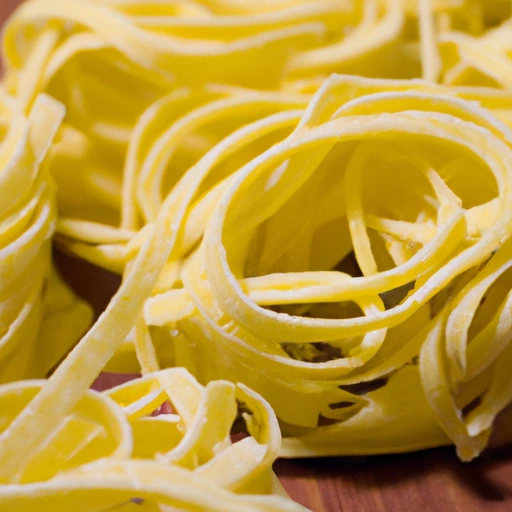Linguine
Description

Linguine is a type of pasta similar to fettuccine and trenette but narrower in width. It is about 4 millimeters (0.16 inches) in width, which is wider than spaghetti but not as wide as fettuccine. The pasta's name comes from the Italian word 'lingue,' meaning 'little tongues.' Linguine is often mistaken for fettuccine or tagliatelle due to its similar shape, but it's important to note the subtle differences in width and texture when preparing dishes.
Common uses
Linguine is commonly used in a variety of dishes that call for a light yet satisfying pasta base. It is particularly well-suited for seafood dishes, light sauces, and pestos. Its slightly flattened shape allows it to hold onto sauces better than round spaghetti, making it a popular choice for dishes with oil or cream-based sauces.
Nutritional value
Calories
Typically, a 2-ounce (57 grams) serving of dry linguine provides around 200 calories.
Protein
That same serving size contains approximately 7 grams of protein.
Fat
Linguine is generally low in fat, with less than 1 gram per serving.
Carbohydrates
Linguine is primarily composed of carbohydrates, with about 42 grams per serving.
Vitamins
Depending on the brand, some linguine may be enriched with vitamins such as B-vitamins.
Minerals
It also provides essential minerals like iron and phosphorus.
Health benefits
As a staple of Mediterranean diets, linguine can be part of a balanced meal. It provides a good source of energy through its complex carbohydrates and can also contribute to protein intake when combined with legumes or cheese.
Potential risks
While linguine can be a healthy component of a balanced diet, overconsumption may lead to weight gain due to its high carbohydrate content. It also contains gluten, which makes it unsuitable for those with celiac disease or gluten sensitivity.
Common recipes
Linguine is famously paired with clams in the classic Italian recipe 'Linguine alle vongole.' It is also used in pasta salads, simple garlic and oil tosses, and with light tomato sauces or creamy Alfredo sauce.
Cooking methods
To cook linguine, bring a large pot of salted water to a boil. Add the pasta and cook for 9 to 11 minutes, or until al dente. Stir occasionally to prevent sticking.
Pairing with other ingredients
Linguine goes well with white wines such as Pinot Grigio or buttery Chardonnay, and it pairs nicely with fresh herbs, cheeses like Parmigiano-Reggiano, and proteins like chicken, shrimp, or tofu.
Summary
Linguine is a versatile pasta that plays a key role in many culinary traditions around the world. With its origins in Italian cooking, linguine has been embraced globally for its ability to complement a wide range of sauces and ingredients. Its nutritional profile makes it a suitable option for various diets when consumed in moderation.